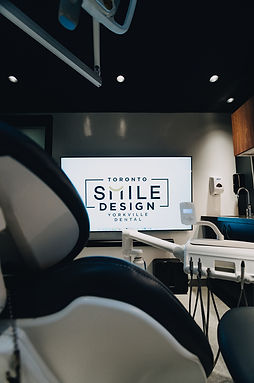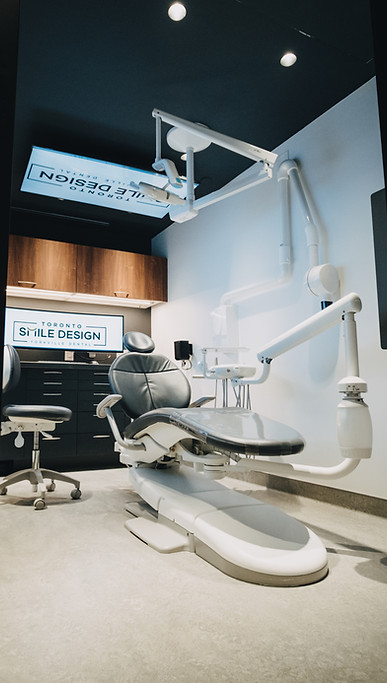SEDATION DENTISTRY
Do you prefer to endure unbearable toothache rather than visit a dentist? With sedation dentistry, you don’t have to avoid your dentist.
Did you know?
WE CAN PROVIDE I.V. SEDATION FOR ALL OF YOUR DENTAL TREATMENTS!

What Is Sedation Dentistry?
Sedation dentistry uses medication or nitrous oxide to eliminate pain, reduce anxiety, and enhance relaxation during dental procedures. Also known as “sleep dentistry," this dental service can make drowsy, semi-unconscious, or unconscious. However, most dental procedures are non-invasive and don't involve physical pain. You can experience discomfort and teeth sensitivity during dental care routines like teeth cleaning. In this case, inhaling nitrous oxide can help reduce sensitivity and enhance comfort. Sedation in dentistry also manages anxiety, dentist phobia, and dental fear. Most people avoid visiting the dentist due to dental anxiety fueled by unfounded fears rather than physical pain. If you’re anxious, your Toronto dentist can use sedation to improve your dental experience.
Here is all you need to know about sedation dentistry and how it can enhance your relaxation, comfort, and experience at the dentist.
Who needs sedation dentistry?
Sedation dentistry can be helpful for individuals of all ages, who may have:
-
dental anxiety
-
dental phobia
-
fear of visiting the dentist
-
an overly sensitive gag reflex
-
aichmophobia (needle phobia)
-
extreme teeth sensitivity
-
claustrophobia while in the dental chair
-
reduced sensitivity to local anesthesia
-
difficulty controlling movements
-
special needs related to physical, cognitive, behavioural factors
Sedation Dentists often recommend sedation dentistry for these individuals.
What types of sedation / types of anesthesia are used in dentistry?
Sedation dentistry in Toronto offers a range of levels that can be customized to suit your specific requirements, taking into consideration factors such as:
-
your anxiety and dental phobia level
-
the duration of the dental procedure
-
your health background
-
personal preferences.
Nitrous oxide, oral conscious sedation, and intravenous (IV) sedation are among the most prevalent kinds of sedation dentistry.
Nitrous Oxide
Nitrous oxide or "laughing gas," is a common form of sedation dentistry. It is administered through a mask or nosepiece, and its calming effects are noticeable within three to five minutes. The amount of sedation is regulated by the dentist and can be adjusted as required throughout the treatment.
After the procedure, the dentist administers pure oxygen to flush the nitrous oxide out of the patient's system. Because the effects of laughing gas are short-lived, the patient can drive home after the procedure.
Oral conscious sedation / Oral Sedation
Oral conscious sedation in Toronto involves taking sedative medication, usually a pill, an hour before the dental procedure. Triazolam, which belongs to the same family as Valium, is commonly used by most dentists. However, other medications such as zaleplon and lorazepam might also be used.
It is essential to have someone to drive you home after the procedure if you receive either oral or IV sedation, as these medications can impair your memory and ability to operate a vehicle.
Intravenous (IV) Sedation / IV Sedation Dentistry
In dentistry, intravenous (IV) sedation is the most profound form of conscious sedation offered. Your medical professional administer sedative drugs directly into your bloodstream via an IV line during the procedure.
Throughout the process, your dentist monitors your oxygen levels, heart rate, and blood pressure, adjusting the dosage and using reversal medications if required. Most individuals who receive IV sedation dentistry typically fall asleep and have minimal to no recollection of the treatment afterward. This method is perfect for those who fear the dentist or need longer treatment sessions.
What happens before sedation dentistry?
You will discuss your sedation options during your initial consultation with your dentist. Your dentist will review your health history and inquire about any medications or supplements you are taking. Based on the gathered information, they will recommend a sedation method that suits your needs.
Generally, you should refrain from eating or drinking anything for at least six hours before your dental appointment unless your dentist instructs you otherwise. However, you should continue taking your routine medications as prescribed.
If you are taking blood thinners like warfarin, inform your dentist. They may ask you to temporarily stop taking these medications a few days before the procedure.


What happens during sedation dentistry?
Prior to your dental procedure, your dentist administers sedative medications to help you relax. Your dentist will typically administer local anesthetic to your mouth after you are already relaxed from sedatives, so that you will not feel discomfort during the procedure.
What happens after sedation dentistry?
If you don't opt for nitrous oxide sedation, it's important to have a trusted friend or family member drive you home after your appointment. Once you reach home, it's best to rest and allow the sedative medication to wear off.
Please note that it's not recommended to take a taxi or rideshare home after sedation dentistry. You'll need someone who is familiar and trustworthy to assist you. Before leaving you alone, your driver should ensure that you're resting comfortably either in bed or on a couch.
What are the benefits of sedation dentistry?
Anxiety Relief
Your Sedation dentist in Toronto significantly benefits patients with varying degrees of anxiety and dental phobia. It can alleviate fear and nervousness, enabling them to undergo dental procedures with ease and comfort. Anxiety levels can vary widely among patients, with some experiencing mild apprehension while others becoming overwhelmingly fearful of potential pain or complications during the procedure.
Unfortunately, this can deter many from receiving necessary dental care. However, sedation dentistry can help address these concerns and enable patients to obtain the required treatment. Patients who experience more significant anxiety will likely benefit more from sedation than those with milder symptoms.
Reduction in Gag Reflex
The gag reflex is necessary to remove foreign objects from the throat. However, it can impede dental procedures if a patient is fully conscious during treatment. This is particularly true if the dentist needs to access deeper parts of the oral cavity, as the gag reflex can interfere.
If a patient's gag reflex is triggered, it can cause discomfort and potentially harm the patient during treatment. Sedation dentistry in Toronto eliminates this issue as the gag reflex is suppressed. This enables the dentist to work more efficiently and effectively while the patient remains comfortable.
Pain Relief
The fear of dental procedures is common and understandable, as nobody likes experiencing tooth or gum pain. However, with sedation dentistry, the pain is entirely eliminated, as the brain is incapable of registering pain while under the
influence of potent sedatives and anesthetics.
The desire for pain-free dental care is universal, and it is one of the primary reasons why sedation dentistry has become increasingly popular.
The Sedation Dentist in Toronto Can Work Faster
Under the influence of potent sedatives and anesthetics, patients will remain still in the chair, making the procedure easier for both the dentist and the patient. The sedation dentist will be able to work faster on your dental treatment and more efficiently since they don't have to worry about the patient's reaction. This allows for a quicker recovery time, and patients who have been avoiding dental work due to nerves may benefit from sedation dentistry.

What are the risks or complications of sedation dentistry?
While sedation dentistry is generally safe when administered by a licensed healthcare professional, there is still a small risk of complications. Potential issues that may arise from taking sedative drugs in the short term could include feeling sleepiness for a prolonged period, being unable to anticipate the effects of the medication, having a parched mouth, feeling sick or throwing up, getting headaches, and having bruises from the intravenous injection. It's important to note that allergic reactions are rare, and drugs are available to counteract any complications that may arise.
Can I have sedation dentistry if I’m pregnant?
Pregnant women are typically advised against undergoing sedation dentistry since some sedative medications can potentially harm fetal development.
In some instances, nitrous oxide may be administered during the second trimester, but most dentists prefer to postpone sedation until after the pregnancy.
What is the recovery time?
The duration of recovery time after sedation dentistry varies based on the type of sedation used and how an individual's body reacts to the medication. Patients receiving nitrous oxide usually recover within 15 to 30 minutes and can drive home after their appointment. However, those who opt for oral conscious or IV sedation may need up to 24 hours to fully recover.
When can you go back to work or school?
After receiving nitrous oxide, you can resume your regular activities immediately after leaving the dental office. However, if you've been given oral or intravenous sedatives, waiting at least one day before returning to work or school is recommended, although some people may need more time. Your dentist can provide more information about what to expect based on your situation.

When can you drive?
After undergoing oral or IV sedation in Toronto, it's important to wait for 24 hours before driving again. However, with nitrous oxide, patients can drive once they have been discharged from the dental office.
When can you eat?
While you can eat and drink immediately after your appointment, it’s common to wait until the numbness from the local anesthesia subsides. Starting with clear liquids is usually best, followed by smoothies or milkshakes. If you feel up to it, you can progress to more substantial foods after a couple of hours.
Your sedation dentist will provide you with postoperative guidelines indicating which food types to avoid and which are safe to eat. You can return to a regular diet within a week for most dental procedures. However, it may take longer if you’ve had work done on both sides of your mouth.
When should you see your healthcare provider?
After undergoing sedation dentistry, it may take a minimum of 24 hours for the effects of sedation to subside. In case you experience any concerning symptoms, such as vomiting or nausea, a fever higher than 101 degrees Fahrenheit (38.33 degrees Celsius), or pain that doesn't alleviate with medication, it's crucial to contact your dentist for further guidance.

Book your Dental Treatment








